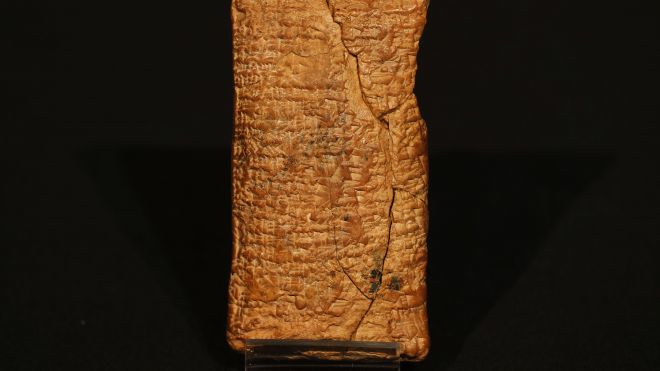

Noah’s Ark, of course, was a large boat that saved two of each animal and a handful of humans from a catastrophic flood sent by God to purge the wicked.
But the typical depiction of a long vessel complete with bow and stern may have been round, or there may have been another ark.
A recently deciphered 4,000-year old clay tablet dating back to ancient Mesopotamia, the birth-place of civilization that now resides in modern-day Iraq, reveals a similar story of the Old Testament Noah’s Ark. The clay tablet came complete with detailed instructions for building a giant round vessel known as a coracle.
It is also gave key instruction that animals should enter “two by two,” just as the instructions were given by God to Noah.
The tablet went on display at the British Museum on Friday. Engineers will follow the ancient instructions to see whether the vessel could actually have sailed, just as they have done in the past with other Biblical vehicles, including other Ark descriptions,and the vehicle that took Enoch in to the heavens.
It’s also the subject of a new book, “The Ark Before Noah,” by Irving Finkel, the museum’s assistant keeper of the Middle East and the man who translated the tablet.
Finkel got the clay tablet a few years ago, after a man brought in a damaged tablet his father had acquired in the Middle East after World War II. It was light brown, about the size of a mobile phone and covered in the cuneiform script used in ancient Mesopotamians.
It turned out, Finkel said Friday, to be “one of the most important human documents ever discovered.”
“It was really a heart-stopping moment — the discovery that the boat was to be a round boat,” said Finkel. “That was a real surprise.”
A round boat makes sense, according to Finkel, because coracles were widely used as river taxis in ancient Iraq and are suitably designed to handle raging floodwaters.
Elizabeth Stone, an expert on the antiquities of ancient Mesopotamia at New York’s Stony Brook University, also agreed that it made sense ancient Mesopotamians would depict their ark as round.
“It’s a perfect thing,” Finkel said. “It never sinks, it’s light to carry.”
Other experts said Finkel wasn’t simply indulging in book-promotion hype. David Owen, professor of ancient Near Eastern studies at Cornell University, said the British Museum curator had made “an extraordinary discovery.”
“People are going to envision the boat however people envision boats where they are,” she said. “Coracles are not unusual things to have had in Mesopotamia.”
The tablet records a Mesopotamian God’s instructions for building a giant vessel, which is two-thirds the size of a soccer field in area, made of rope, strengthened by wooden ribs and coated in bitumen.
Finkel said that on paper (or stone) the boat-building orders appear sound, but he doesn’t yet know whether it would have floated. A television documentary due to be broadcast later this year will follow attempts to build the ark according to the ancient manual.
The flood story recurs in later Mesopotamian writings including the “Epic of Gilgamesh,” and nearly all of the ancient texts from around the world contain a strikingly similar version, as well. Vocal, or oral versions of the flood story lack the technical instructions — cut out, Finkel believes, because it wouldn’t have been conducive to storytelling.
“It would be like a Bond movie where instead of having this great sexy red car that comes on, somebody starts to tell you about how many horsepower it’s got and the pressure of the tires and the capacity of the boot (trunk),” he said. “No one cares about that. They want the car chase.”
Finkel is aware his discovery may cause consternation among believers in the Biblical story. After nineteenth century British Museum scholars first learned from cuneiform tablets that the Babylonians had a flood myth, they were disturbed by its striking similarities to the story of Noah.
“Already in 1872 people were writing about it in a worried way — What does it mean that Holy Writ appears on this piece of Weetabix?” he quipped, referring to a cereal similar in shape to the tablet.
“I’m sure the story of the flood and a boat to rescue life is a Babylonian invention,” he said.
He doesn’t think the tablet provides evidence the ark described in the Bible existed. Finkel believes it’s more likely that a devastating real flood made its way into oral memory, which the Jews simply passed on.
“I don’t think the ark existed — but a lot of people do,” he said. “It doesn’t really matter. The Biblical version is a thing of itself and it has a vitality forever.” He failed to address the mountain discovery of what is believed to be the actual ark in the Noah’s Ark story. Archeologists have not uncovered the massive boat buried beneath the mountain’s surface.
“The idea that floods are caused by sin is happily still alive among us,” he added, pointing out a local councilor in England who made headlines recently for saying Britain’s recent storms were caused by the legalization of gay marriage.
“Had I known it, it would have gone in the preface of the book,” Finkel said.







